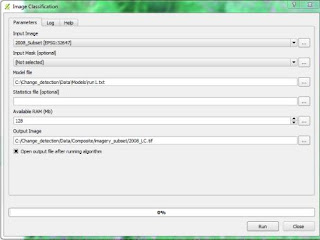construct
a single-date land cover map by classification of a cloud-free composite generated from Landsat images;
and complete an accuracy assessment of the map output. The tools for completing this work will be
done using a suite of open-source tools, mostly focusing on QGIS.
The land cover map will be created by training a machine learning algorithm, random forests, to predict land cover across the landscape. The random forests model is trained from a user generated reference data set – collected either in the field or manually through examination of remotely sensed data sources.
The resulting model is then applied across the landscape. Finally you will assess agreement with a second reference data set generated using a stratified random sampling process and high resolution aerial imagery.
The reference data set will be compared to the classified map image to determine the accuracy estimates. Modules 3 and 4 have been adapted from Exercises and material developed by Dr. Pontus Olofsson, Christopher E. Holden, and Eric L. Bullock at the Boston Education in Earth Observation Data Analysis in the Department of Earth & Environment, Boston University. To learn more about their materials and
their work, visit their github site at https://github.com/beeoda
Introduction
The tools for completing the workflow in this module are all open-source; QGIS is the primary tool used to complete both the land cover map and land cover change map workflow. A QGIS install was created from the OSGeo4W and is included on the website for download.
It includes these additional packages:
GDAL
Orfeo ToolBox
QGIS
Python
Objectives
Explore the QGIS Terminal
Create a false color image from the SWIR, NIR, and Red bands from the cloud free Landsat composite image,
Stack image bands, and
Do some basic image band arithmetic.
The land cover map will be created by training a machine learning algorithm, random forests, to predict land cover across the landscape. The random forests model is trained from a user generated reference data set – collected either in the field or manually through examination of remotely sensed data sources.
The resulting model is then applied across the landscape. Finally you will assess agreement with a second reference data set generated using a stratified random sampling process and high resolution aerial imagery.
The reference data set will be compared to the classified map image to determine the accuracy estimates. Modules 3 and 4 have been adapted from Exercises and material developed by Dr. Pontus Olofsson, Christopher E. Holden, and Eric L. Bullock at the Boston Education in Earth Observation Data Analysis in the Department of Earth & Environment, Boston University. To learn more about their materials and
their work, visit their github site at https://github.com/beeoda
Introduction
The tools for completing the workflow in this module are all open-source; QGIS is the primary tool used to complete both the land cover map and land cover change map workflow. A QGIS install was created from the OSGeo4W and is included on the website for download.
It includes these additional packages:
GDAL
Orfeo ToolBox
QGIS
Python
Objectives
Explore the QGIS Terminal
Create a false color image from the SWIR, NIR, and Red bands from the cloud free Landsat composite image,
Stack image bands, and
Do some basic image band arithmetic.
Download Link




No comments:
Post a Comment